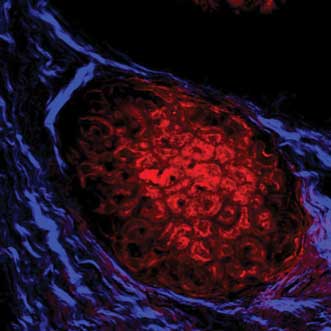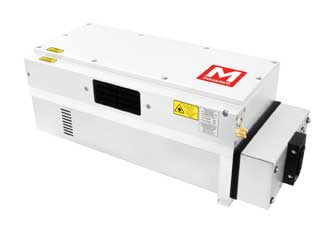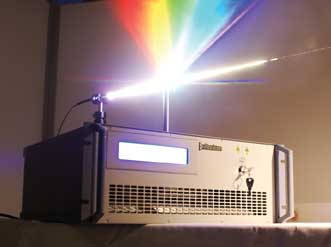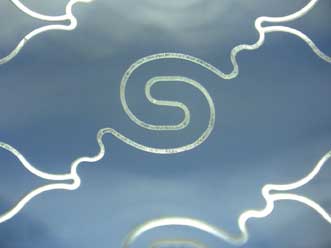Improvements in ultrafast lasers support superior surgical precision, take imaging deeper and help to unlock the secrets of the brain.
With their unique ability to deliver high peak power without thermal damage, ultrafast lasers are ideally suited for biological and biomedical applications. And with advances being realized in performance, reliability and cost, we are seeing ultrafast lasers displace other laser technologies in a range of bio applications as well as open up applications not previously possible with other technologies – laser or nonlaser.
Moderate power levels protect the samples from heating or optical damage, while high-peak-power densities drive nonlinear optical effects in biological tissues, enabling micron-level 3-D resolution in imaging, or clean tissue ablation with no heat-affected zone or postsurgery adverse effects. Moreover, in the past decade, ultrafast lasers also have become turnkey, dependable light sources with low cost of ownership and high uptime – a key requirement for bio applications.

Multimodal image of excised tissue from the human eyelid using an InSight DeepSee laser. It shows the acinus of a meibomian gland, a special organ that produces meibum, an oily substance that prevents dehydration of the eye’s tear film. The image shows the CARS signal of lipids (red) and the SHG signal from collagen that surrounds the gland (blue). The dark circle in each of the cells is the nucleus, which is largely devoid of lipids. Image actual size is ~350 x 350 µm. Courtesy of Dr. Eric Potma, University of California, Irvine.
“Ultrafast lasers offer several key advantages that make them a great fit for bio applications,” said Julien Klein, senior manager of product marketing at Spectra-Physics, a Newport Corp. brand based in Stahnsdorf, Germany. “They generate ultrashort pulses on the order of tens or hundreds of femtoseconds (10–15 seconds) with quasi-ideal Gaussian spatial beam profiles. When tightly focused, the lasers generate extremely high peak power densities with relatively moderate average power of a few hundreds milliwatts at the sample.”
Imaging
By far, the biggest application for femtosecond lasers is nonlinear imaging, often referred to collectively as MPE (multiphoton excitation) imaging. Excitation occurs only at the focus of an ultrafast laser, and scanning the focus of the laser enables a microscope to build up an image of the sample.
“A 3-D picture of the sample can be built up by focusing deeper into the sample. The average powers can be maintained at sufficiently low levels that sample damage is limited such that live samples can be imaged over extended periods of time,” said David Armstrong, marketing director at M Squared Lasers Ltd., a diode-pumped solid-state (DPSS) laser manufacturer based in Glasgow, Scotland.

The Sprite-XT is a compact mode-locked Ti:sapphire laser from M Squared Lasers Ltd. Courtesy of M Squared Lasers.
Some rely on two-photon effects such as two-photon excitation, SHG (second-harmonic generation) and SRS (stimulated Raman scattering); e.g., SHG can be used to quantify crystal structure and content in proteins and pharmaceuticals, where the SHG signal occurs only in the presence of noncentrosymmetric-ordered crystals.
Others are based on three-photon effects including three-photon excitation, THG (third-harmonic generation) and CARS (coherent anti-Stokes Raman scattering).
“One specific advantage in multiphoton imaging applications is that the IR wavelengths used with ultrafast lasers penetrate more deeply into living tissue and thereby enable deeper imaging than other optical techniques,” said Marco Arrigoni, marketing director for the scientific market at laser provider Coherent Inc. of Santa Clara, Calif.
Fluorescence-based imaging techniques such as FLIM (fluorescence lifetime imaging), and FRET (Förster resonance energy transfer) and TCSPC (time-correlated single-photon counting) are used to understand the dynamical processes found in many biological structures.
“Supercontinuum sources from Fianium (Whitelase SC series) are widely used in these studies,” said Colin Seaton, vice president of sales and marketing at Fianium Inc., an ultrafast laser specialist with headquarters in Southampton, England. “There are multiple models providing broad spectral coverage from below 390 nm to beyond 2 µm at powers ranging from hundreds of milliwatts to tens of watts. These continuous-white-light outputs are made up of a high-repetition-rate (20 to 80 MHz) pulses-of-picoseconds duration, which is essentially instantaneous excitation on the timescale of most biological processes.”

Supercontinuum sources from Fianium Inc. offer broad spectral coverage at a range of powers.
Courtesy of Fianium.
The wide spectral bandwidth of ultrafast lasers also is useful in optical coherence tomography, widely used to provide 3-D images of tissue. Here, the very broad spectral output of supercontinuum lasers allows for very high axial resolution imaging in multiple user-defined wavelength bands optimized for the tissue being imaged.
“The high power and spectral brightness of supercontinuum lasers also allows for deep-tissue imaging, such as in highly scattering media, or in vivo imaging, where signal levels can be very low,” Seaton said.
Beyond lasik to cataract surgery
At higher powers, the fluence at the focal region of the laser can be sufficient to selectively ablate material. Applications include lasik, eye surgery and selective ablation of regions of biological samples.
“From an OEM and commercial applications viewpoint, a major benefit of the high peak power with minimal thermal effects [of ultrafast lasers] is that this combination enables cold ablation in therapeutic interventions,” said Matthias Schulze, Coherent’s marketing director for OEM components and instrumentation.
Tissue can be destroyed or cut with unprecedented spatial precision in 3-D without the risk of causing thermal damage to surrounding tissues. And for improved patient outcomes, surgeons are increasingly turning to femtosecond lasers to carry out procedures previously possible with nanosecond or picosecond pulsed lasers.
“I was recently at the annual American Conference of Ophthalmology [in November, in New Orleans] along with 32,000 other attendees, where there was a lot of buzz about ultrafast lasers,” Schulze said. “I’m not talking about all-laser lasik, which you can almost classify now as a legacy application [there are nearly 4000 ultrafast lasers in the field for this elective procedure]. Rather, the new hot application is cataract surgery.”
One advantage of ultrafast lasers is that the same laser can perform up to many different parts of the procedure. First, it can be used to fragment the incipient lens, often with no need for ultrasound. This benefit is not only a question of complexity and patient discomfort, but there is also currently quite a debate about the potential negative impact of using any ultrasound in the eye.
The same laser can then be used to cut the capsule ready to accept the new intraocular lens (IOL), to make the incisions through which the foldable IOL is inserted, and to make cuts in the cornea to correct any astigmatism.
Latest laser developments
A great deal of progress has been made in transforming ultrafast lasers from large open-architecture systems requiring a great deal of expert attention to “black boxes” requiring no interaction. But further advances are required to increase the number of researchers in biology who are willing or able to use ultrafast lasers.
“Overall cost and what that money will buy in terms of flexibility – e.g., wavelength range and power – [remain] a considerable barrier, with an ultrafast laser representing one of the biggest single investments they will make,” Armstrong said.
“Reduction in cost may in part be facilitated by less-complex architectures, such as direct-diode pumping of gain material, fiber lasers and use of semiconductor materials, although some of these approaches may trade off restricted flexibility for lower cost. Advances in flexibility could be driven by taking advantage of the wide tunability offered by OPOs [optical parametric oscillators].”

Stent with ultrafine structures fabricated with a Spirit industrial femtosecond laser. Strut widths and thicknesses are <50 mm. Courtesy of Spectra-Physics, a Newport Corp. brand.
Ultrafast fiber lasers
Fianium’s Seaton also believes that over the next few years, we should expect greater penetration of various ultrafast fiber lasers into biomedical study. “The low cost structure, versatility and unprecedented reliability will open up new applications which [are] currently either locked because of unavailability of suitable laser sources or simply inaccessible because of [the] prohibitively high cost of such lasers,” he said.
There are considerable advantages to the fiber laser platform in terms of size, cooling requirements and cost compared with traditional DPSS femtosecond lasers, particularly for ophthalmic surgery.
Other up-and-coming applications of ultrafast lasers include fabrication of implantable medical devices such as cardiovascular stents, intraocular lenses, prosthetics and catheters.
“Stents previously were commonly manufactured with nanosecond pulsed lasers, but new materials and finer structures for cardiovascular and peripheral stents with improved biocompatibility require femtosecond lasers,” Klein said.